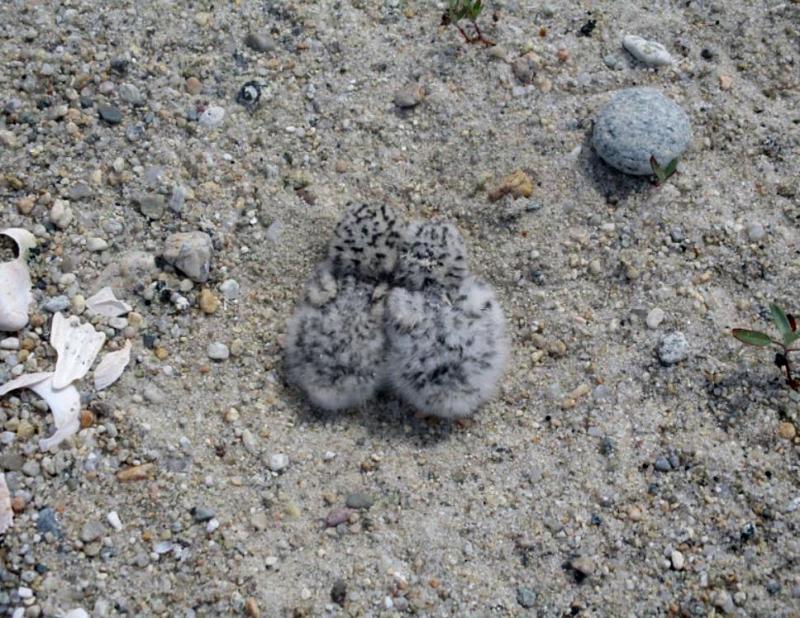Shorebird Season Summary: Least Terns find West Island, Bakers Beach Chicks Fledge After Rescue - by Jamie Bogart, Lloyd Center Research Associate
Aug 1, 2018
This was a different shorebird season for the Lloyd Center. For the first time in three decades, we weren’t in charge of protecting state-owned sites, most notably Horseneck Beach, which the Lloyd Center has managed since plovers became endangered in 1985. The site went into the hands of the Commonwealth’s Department of Conservation and Recreation (DCR), as has occurred at other DCR sites, due largely to operational complexities originating from a restoration project that increased shorebird activity near human use areas.
Some contracts did come through however, including one with the Town of Fairhaven, with whom the Lloyd Center partnered to fulfill the relatively intensive management requirements for shorebirds on busy West Island.
Visitors to West Island during the summer are familiar with the tern activity, as all three species nesting in the region (Common, Roseate, Least) can be seen flying along the periphery, diving for fish, sometimes in giant flocks over the water, or roosting on the rocks. Least Terns share habitat with Piping Plovers, yet the terns have never nested on the island. This season for whatever reason four to five pairs nested on the small spit near the parking lot, where a plover pair also nests each year; and although coyote ultimately predated the colony, the confirmation of nesting including successful hatching is exciting.
Milestones were reached for plovers as well. Of an unprecedented eight nesting pairs on the island simultaneously, seven occurred on town property, including nests close to the public beach. All but one nest hatched on the first attempt, for the most hatchlings ever present at one time on the island. This is also significant considering that all initial nests were unexclosed and nest predation rates have been high in recent years. As expected, given the high density of plover chicks present at one time, some hatchling predation did occur. However, 17 chicks have fledged. Additionally, four young hatchlings from a July 10 hatch are going strong, ensuring a record for fledges at West Island. This recent hatch for the one renest is the first successful hatch of an unexclosed nest since 2012.
The Lloyd Center also contracted with privately owned Bakers Beach in Westport, the return to a site that was last managed by the Lloyd Center in 2002. The Center was brought in to manage the beach’s tricky parking lot pair, to provide a monitoring and educational presence, and to give input on a beach management plan that includes stipulations for shorebirds.
After the owners graciously fenced off a portion of their lot as they do each year, and the use of a predator exclosure for a pair that accepts the cages well, the brood hatched on June 8. This hatch was especially significant since it was the only exclosed nest on the entire barrier beach, including Horseneck Beach, in a year when considerable nest predation occurred on unexclosed nests, and therefore depicts the continued value of exclosures in deterring predators.
On July 3, three of four chicks fledged, which is a big accomplishment, considering the birds must spend some time in an operational parking lot and cross a public beach to reach the intertidal zone. Luckily, the hot weather waited, so there were no crowds to prevent the birds from moving when their legs were still weak. This is not to say, however, that there were no obstacles to overcome.
In what already likely receives the award for the most strange/unusual shorebird event of the season statewide, two chicks were rescued on the same morning in the span of one hour. One was found in a plastic toy pail submerged below the sand surface, drowning in a shallow layer of water. This chick was held for a short period while searching for the rest of the brood, then released back to the dune where it slowly recovered.
While a single chick was alone back in the dirt parking lot near the hatch site, the third chick was also unaccounted for. By chance, the monitor walked over the parking lot’s storm drain, and heard chirping from below! Sure enough, the chick had fallen through the spaces of the drain. The beach owner, very nonchalantly, fetched a crowbar and opened the manhole-cover style drain, from which the monitor retrieved the confused but healthy hatchling. While either rescue is not unheard of in plover lore, the occurrence of both on the same day and discovery of both birds by the monitor only minutes apart is astonishing.
These events and a parking lot pair also sheds light on management complexities that can exist on even small sites. And although one chick is slow to fly, each bird is safe now, and still returns to the lot on busy days to rest, and reminisce?
Tune in next season when more interesting shorebird events will be ready to unfold!













